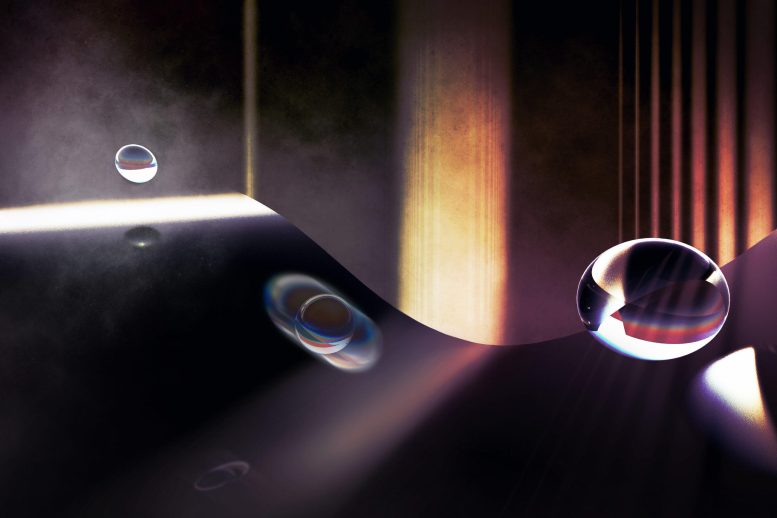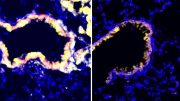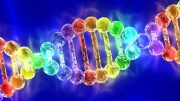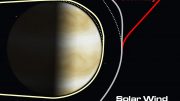
A nanoscale-sized glass bead evolving in a potential created through electrostatic or magnetic forces enters a macroscopic quantum superposition state. Credit: Helene Hainzer
Making a nanoscale-sized glass bead exhibit quantum effects at macroscopic scales.
The distinction between the ordinary world and the quantum realm remains ambiguous. As an object increases in size, its localization intensifies when it undergoes quantum transformation by cooling its motion to absolute zero.
Researchers, led by Oriol Romero-Isart from the Institute for Quantum Optics and Quantum Information (IQOQI) of the Austrian Academy of Sciences (ÖAW) and the Department of Theoretical Physics at the University of Innsbruck, propose an experiment in which an optically levitated nanoparticle, cooled to its ground state, evolves in a non-optical (“dark”) potential created by electrostatic or magnetic forces. This evolution in the dark potential is expected to rapidly and reliably generate a macroscopic quantum superposition state.
Overcoming Challenges in Quantum Experiments
Laser light can cool a nanoscale-sized glass sphere to its motional ground state. Left alone, bombarded by air molecules and scattering incoming light, such glass spheres quickly heat up and leave the quantum regime, limiting quantum control. To avoid this, the researchers propose letting the sphere evolve in the dark, with the light switched off, guided solely by nonuniform electrostatic or magnetic forces. This evolution is not only fast enough to prevent heating by stray gas molecules but also lifts the extreme localization and imprints unequivocally quantum features.
Addressing Practical Challenges and Future Prospects
The recent paper in Physical Review Letters also discusses how this proposal circumvents the practical challenges of these type of experiments. These challenges include the need for fast experimental runs, minimal use of laser light to avoid decoherence, and the ability to quickly repeat experimental runs with the same particle. These considerations are crucial in mitigating the impact of low-frequency noise and other systematic errors.
This proposal has been extensively discussed with experimental partners in Q-Xtreme, an ERC Synergy Grant project financially supported by the European Union. “The proposed method is aligned with current developments in their labs and they should soon be able to test our protocol with thermal particles in the classical regime, which will be very useful to measure and minimize sources of noise when lasers are off,” says the theory team of Oriol Romero-Isart. “We believe that while the ultimate quantum experiment will be unavoidably challenging, it should be feasible as it meets all the necessary criteria for preparing these macroscopic quantum superposition states.”
Reference: “Macroscopic Quantum Superpositions via Dynamics in a Wide Double-Well Potential” by M. Roda-Llordes, A. Riera-Campeny, D. Candoli, P. T. Grochowski and O. Romero-Isart, 8 January 2024, Physical Review Letters.
DOI: 10.1103/PhysRevLett.132.023601
The study was funded by the European Research Council.









The distinction between the ordinary world and the quantum realm remains ambiguous. This just is the consequence of physics being fooled by pseudoscientific theories.
For half a century, the Physical Review Letters (PRL) that you believe in has been spreading pseudo scientific theories and being self righteous and stubborn. This behavior seriously poisons the academic atmosphere and has become a cancer that hinders the development and progress of human science.
I hope researchers are not fooled by the pseudoscientific theories of the Physical Review Letters (PRL), and hope more people dare to stand up and fight against rampant pseudoscience.
The so-called academic journals (such as Physical Review Letters, Nature, Science, etc.) firmly believe that two objects (such as two sets of cobalt-60) of high-dimensional spacetime rotating in opposite directions can be transformed into two objects that mirror each other, is a typical case of pseudoscience rampant.
If researchers are really interested in Science and Physics, you can browse https://zhuanlan.zhihu.com/p/643404671 and https://zhuanlan.zhihu.com/p/595280873.
The interaction of topological vortices gives humanity infinite possibilities. If you are interested, you can browse https://zhuanlan.zhihu.com/p/390071860 and https://zhuanlan.zhihu.com/p/463666584.
We cannot believe your pseudoscience.
Agree!
You are indeed an excellent pupil appreciated by the Physics Review Letters (PRL).
You can go home and do a physics experiment according to the theory of the Physics Review Letters (PRL), having your Dad and Mom rotate in two opposite directions, so that they can transform into two people who are mirror images of each other. At this time, it is up to you to decide how to distinguish between your Dad and Mom.
This is the greatest contribution of the Physics Review Letters (PRL) to science and physics.
Blessing you!